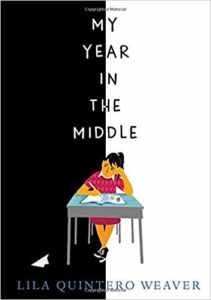 In a small town in Alabama in 1970, Lu Olivera sits in the middle of her newly integrated sixth grade class. On one side of the classroom are the Black kids, at Red Grove Middle School for the first time. On the other are the white kids who don’t want them there, and whose families are planning to send them to an all-white “segregation academy” the following year. Lu’s family immigrated from Argentina, and while she is considered “white,” she doesn’t feel a part of their group, especially since all of her old friends are joining mean-girl Missy’s clique. But when Lu wins a gym-class long-distance footrace, beating the athletic new student Belinda Gresham, things change. Belinda, who is Black, embraces her competitor, and the two begin practicing together for a Field Day showdown with other schools in the area. The white girls, though, shun Lu further because of her friendship with Belinda. And when Lu is invited to an elite track camp, she has to deal with a mother who considers sports inappropriate for girls.
In a small town in Alabama in 1970, Lu Olivera sits in the middle of her newly integrated sixth grade class. On one side of the classroom are the Black kids, at Red Grove Middle School for the first time. On the other are the white kids who don’t want them there, and whose families are planning to send them to an all-white “segregation academy” the following year. Lu’s family immigrated from Argentina, and while she is considered “white,” she doesn’t feel a part of their group, especially since all of her old friends are joining mean-girl Missy’s clique. But when Lu wins a gym-class long-distance footrace, beating the athletic new student Belinda Gresham, things change. Belinda, who is Black, embraces her competitor, and the two begin practicing together for a Field Day showdown with other schools in the area. The white girls, though, shun Lu further because of her friendship with Belinda. And when Lu is invited to an elite track camp, she has to deal with a mother who considers sports inappropriate for girls.
That year in Alabama was the time of a polarizing election, with racist governor George Wallace angling for a political comeback against a more moderate Democrat, Albert Brewer, who he derided as “Sissy Britches.” The election polarizes the town. Lu finds herself attracted to classmate Sam, whose minister father went to jail for his support of the civil rights movement. Her best friend, Abigail, is moving toward the Wallace side, even though her father openly supports Brewer. And while Lu’s own family plans to vote for Brewer, her older sister has become a vocal supporter, worrying her parents who say, “We’re foreigners. We’re not supposed to get involved.”
Based on Lila Quintero Weaver’s experience of growing up in central Alabama as an immigrant from Argentina under the reign of George Wallace, My Year in the Middle captures the language, emotions, and way of life of that era. The Southern expressions of the mid-twentieth century add humor and set the reader firmly in a place and time. The experience of being abandoned by old friends, invited to a party for the express purpose of being shunned and humiliated by the host and her crowd, and attracted to a classmate but not knowing what to say are universal. And, sadly, much of Weaver’s story has become part of young people’s lives today, as we watch our classmates, neighbors, and friends, one by one, choose hatred and exclusion over acceptance of diversity and working together to make things better for everyone. Lu’s evolution from one who remains invisible to speaking out for herself, her friends, and what is right offers a model for readers growing up at a time when Wallace’s ideas and tactics have gone nationwide and his political heirs are riding high.
1 comment for “Learning to Take a Stand: A Review of My Year in the Middle”